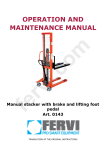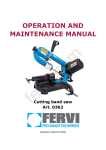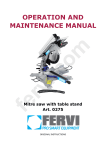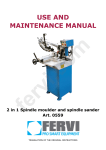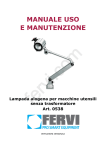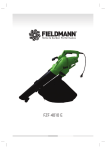Download OPERATION AND MAINTENANCE MANUAL Digital
Transcript
fe rv i.c om OPERATION AND MAINTENANCE MANUAL Digital dynamometers Art. D012/0100, D012/0300, D012/0500, D012/1000 ORIGINAL INSTRUCTIONS MEASURING INSTRUMENTS FOREWORD Read this manual before operating any machinery Operator Qualification om ORIGINAL INSTRUCTIONS Before starting any operation it is compulsory to read this instruction manual. The guarantee of smooth operation and full performance of the instrument is highly dependent on the application of all the instructions contained in this manual. We fe rv i.c The workers responsible for using this tool must have all the necessary information, education and receive adequate training regarding safety, including: a) The conditions of use of the equipment; b) Foreseeable abnormal situations, pursuant to Article 73 of Legislative Decree 81/08. guarantee the instrument complies with the specifications and technical instructions described in the Manual on the date of its issuance (shown in this page). On the other hand, the instrument may also be subject to important technical changes in the future, without the manual being updated. Therefore, see FERVI for information about modifications that could be implemented. REV. 4 Page 2 of 24 October 2013 MEASURING INSTRUMENTS CONTENTS 1 INTRODUCTION ........................................................................................ 4 2 GENERAL SAFETY WARNINGS ................................................................... 6 2.1 2.2 3 Technical support.......................................................................................................7 Other provisions ........................................................................................................7 INTENDED USE AND DESCRIPTION OF THE INSTRUMENT......................... 8 3.1 3.2 3.3 3.4 Main parts of the digital dynamometer ......................................................................9 Identification plate .................................................................................................. 11 Restricted use symbol.............................................................................................. 11 Safety devices.......................................................................................................... 12 TECHNICAL SPECIFICATIONS ................................................................. 13 5 IMPROPER USE AND CONTRAINDICATIONS............................................ 14 6 TRANSPORTING, LIFTING AND DISPLACEMENT...................................... 14 7 COMMISSIONING.................................................................................... 15 USING THE DYNAMOMETER .................................................................... 16 8.1 8.2 8.3 8.4 8.5 8.6 9 Mounting the components........................................................................................ 17 Start-up and programming of the instrument .......................................................... 18 Remote control ........................................................................................................ 19 RS 232 Port.............................................................................................................. 19 Connection to the network....................................................................................... 20 Sub setup menu ....................................................................................................... 21 MAINTENANCE ........................................................................................ 22 9.1 Routine maintenance ............................................................................................... 22 fe 8 General warnings ..................................................................................................... 15 Unpacking instructions ............................................................................................ 15 Preliminary testing .................................................................................................. 15 rv i.c 7.1 7.2 7.3 om 4 10 DECOMMISSIONING ............................................................................... 23 10.1 10.2 Inactivity of the dynamometer ............................................................................. 23 Disassembly and disposal of materials and components ....................................... 23 11 CONTROL REGISTER ............................................................................... 24 Page 3 of 24 MEASURING INSTRUMENTS 1 INTRODUCTION rv i.c om This manual is delivered with the device, and it must be regarded as an inseparable part of it. The manufacturer holds all ownership to material and intellectual property of this manual; any disclosure or copying, even partial, of this publication without prior written consent is forbidden. The purpose of this manual is to provide the knowledge necessary for the use and maintenance of the Dinamometro digitale (D012/0100, D012/0300, D012/0500, D012/1000) and create a sense of responsibility and an understanding of the capabilities and limitations of the means entrusted to the operator. Operators must be properly trained and prepared, so make sure that this manual is read and consulted by the staff responsible for commissioning, operation and maintenance of the device. This is to make all operations as safe and effective as possible for those who carry out these tasks. Therefore, it is imperative to strictly comply with the requirements in this manual, a necessary condition for safe and satisfactory operation of the Dinamometro digitale. Before starting operation, installation and usage of the device, authorised personnel must therefore: carefully read this technical document; know which protections and safety devices are available on the Dinamometro digitale, their location and how they work. The buyer is responsible for ensuring that users are properly trained, that they are aware of all the information and instructions in this document and that they are aware of the potential risks of operating the hoist. The manufacturer waives any and all responsibility for damage to people and/or things caused by non-observance of the instructions in this manual. fe Users will be held fully responsible for any changes made to the device and the manufacturer will not, therefore, be held responsible for any damage caused to persons and/or property resulting from maintenance performed by unqualified personnel and in a manner that differs from the operating procedures shown below. The Dinamometro digitale was designed and built with mechanical guards and safety devices designed to protect the operator/user from possible injury. It is strictly forbidden to modify or remove guards, safety devices and caution labels. If this must be done (for example, for cleaning or repair), make sure that no one can use the device. Page 4 of 24 MEASURING INSTRUMENTS GRAPHIC FORM OF THE ALERTS RELATED TO SAFETY AND OPERATION, AND RISK WARNINGS The following boxes are designed to attract the attention of the reader / user for the proper and safe use of the device: Pay attention This highlights behavioural rules to prevent damage to the device and/or the occurrence of dangerous situations. Residual Risks fe rv i.c om This highlights the presence of dangers that cause residual risks to which the operator must pay attention in order to avoid injury or damage to property. Page 5 of 24 MEASURING INSTRUMENTS 2 GENERAL SAFETY WARNINGS Even if you are already familiar with the Dinamometro digitale, you must read this manual carefully to acquire full knowledge of the device and the general precautions to be observed during operation. Lifting is not permitted The Dinamometro digitale is NOT a lifting device! om Risks associated with using the dynamometer rv i.c Despite the implementation of all safety devices for safe use of the equipment, it is necessary to take note of all the accident prevention requirements highlighted in various parts of this manual. Risks associated with using the dynamometer Each and every person who is responsible for the use and maintenance of the device should first have read the instruction manual, particularly the chapter dealing with safety. Risks associated with using the dynamometer fe The device must only be used by qualified personnel trained to use the device by authorised personnel. Page 6 of 24 MEASURING INSTRUMENTS Use of PPE Before starting any type of work with the Dinamometro digitale, the operator must wear appropriate personal protective equipment (PPE) such as crush resistant safety gloves and shoes. fe rv i.c om 1. Do not try to operate the device at higher performance levels than those for which it was designed, in particular regarding the magnitude of the load. In other words, do not load the Dinamometro digitale beyond its capacity. 2. Use the Dinamometro digitale exclusively for the measurement of pulling force, and only according to the intended manner and for the uses described in this instruction manual. 3. Before connecting the Dinamometro digitale, always check: the efficiency and integrity of the device, and in particular the hooks, the pins and rings; the strength and integrity of the support structure to which the device is attached. 4. Keep the work / operation area tidy and free of clutter; untidiness causes accidents. 5. Make sure that children, unauthorised persons and animals are not allowed in the work environment. 6. Work areas must be well lit. 7. It is recommended that users of this publication, for maintenance and repair, have a basic knowledge of mechanical principles and of repair technique procedures. 8. Replace worn or damaged parts, check that the repairs and protection work correctly before operating. Eventually, if necessary, have it checked by Service staff. Use only original spare parts. 9. The person responsible for company safety is to make sure that the staff responsible for using the device have read and understood this manual in its entirety. 10.The company safety manager is responsible for monitoring the company's risk status according to Legislative Decree no. 626/94 and subsequent modifications and amendments. 2.1 Technical support For any problems or concerns please do not hesitate to contact your dealer, which has competent and specialised staff, specific equipment and spare parts. 2.2 Other provisions IT IS FORBIDDEN TO TAMPER WITH SAFETY DEVICES The first thing to do when starting work is to check the presence and integrity of the guards and the operation of safety devices. If any defect is encountered do not use the Dinamometro digitale! Page 7 of 24 MEASURING INSTRUMENTS 3 INTENDED USE AND DESCRIPTION OF THE INSTRUMENT om The Dinamometro digitale (D012/0100, D012/0300, D012/0500, D012/1000) is a manually operated portable measuring device suitable for measuring pulling forces or weight, for lifting. It is, therefore, particularly suitable for all temporary applications, which take place indoors or outdoors and where there is no electricity network, such as: warehouses, construction sites, farms, mines, quarries, ports and shipyards. To use the device, it must be hooked onto a support structure of sufficient strength such as fixed load-bearing structures or means. The device can be used outdoors if it is protected from the weather and especially from the effects of the wind. The level of protection is IP65. The operating temperature is within the range of -20 / +50°C. The environment must also be sufficiently illuminated so as to ensure operation in maximum safety (at least 50 lux is recommended). rv i.c Other types of use, or the extension of use beyond that envisaged, does not correspond to the designation attributed by the manufacturer, and therefore the latter cannot accept any responsibility for any damage resulting therefrom. IT CAN NOT BE USED FOR COMMERCIAL TRANSACTIONS WITH THIRD PARTIES !!! fe Intended use and maximum capacity The device was designed and manufactured for a specific use, different uses and noncompliance with technical parameters established by the Manufacturer may be hazardous to the operator. Specifically, load weight should NEVER exceed maximum capacity of the device. Page 8 of 24 MEASURING INSTRUMENTS 3.1 Main parts of the digital dynamometer The Dinamometro digitale consists of: steel casing (1), containing the load cell and the electronic control and display parts and a RS232 connection port; a hook (2) to which the load is attached; a shackle (3), for attaching the Dinamometro digitale to the supporting structure; the battery charger (4); the radio control (5). 5 1 om 2 rv i.c 3 4 1 2 3 fe Figure 1 - Close-up of the main parts. Box 4 Battery charger Hook 5 Radio control Attachment shackle Page 9 of 24 MEASURING INSTRUMENTS The control system of the Dinamometro digitale D012/0100, D012/0300, D012/0500, D012/1000 consists of an on/off switch (6) a exchange button (7), a data memory button (8) and a reset button (9). 8 9 rv i.c 7 om 6 Figure 2 – Close-up of the controls Start button 7 SWITCH button 8 HOLD button 9 ZERO button fe 6 For a detailed explanation about how to use the device and its functioning, refer to Chapter 8 of this manual. Page 10 of 24 MEASURING INSTRUMENTS 3.2 Identification plate rv i.c om The following identification plate is attached to the device: fe Figure 3 - Close-up of EC label. MAXIMUM CAPACITY VALUE The plate shows the maximum load capacity. This maximum load capacity must not be exceeded under any circumstance. 3.3 Restricted use symbol This pictogram on the right, giving information regarding the mode of use of the instrument appears on the identification plate. It means that the unit is subject to restrictions of use referred to in letter b), point 2, Article 1 of Directive 90/384/EEC on non-automatic weighing instruments, i.e. IT CAN NOT BE USED FOR COMMERCIAL TRANSACTIONS WITH THIRD PARTIES. M Page 11 of 24 MEASURING INSTRUMENTS 3.4 Safety devices The main safety device present on the device is the safety closing device on the hooks, to prevent the load falling off during normal use. Use of P.P.E. om Figure 4 – Hook closure safety device rv i.c In any case, ALWAYS use appropriate personal protective equipment such as safety gloves and shoes and, if necessary, a protective hard hat. fe Figure 5 – Personal Protective Equipment. Page 12 of 24 MEASURING INSTRUMENTS 4 TECHNICAL SPECIFICATIONS Description 0100 0300 0500 1000 Maximum capacity (kg) 1000 3000 5000 10000 Minimum capacity (kg) 0.200 0.500 1 2 Reading (g) 200 500 1000 2000 Degree of protection IP63 IP63 IP63 IP63 14 14.5 21 34 Power supply (V= /Ah) 6 / 10 6 / 10 6 / 10 6 / 10 Adaptor AC/DC (V/Hz) 230 / 50 230 /50 230 / 50 230 / 50 0 ÷ 40 0 ÷ 40 0 ÷ 40 0 ÷ 40 70 70 70 70 -10 ÷ 50 -10 ÷ 50 -10 ÷ 50 -10 ÷ 50 90 90 90 90 Net weight (kg) Operating temperature (°C) om Operating RH (%RH) Storage temperature (°C) fe rv i.c Storage RH (%RH) Figure 6 – Dimensions. All the dimensions are in mm. Article A B C D E F G D012/0100 260 195 50 40 620 73 200 D012/0300 260 195 60 50 650 73 200 D012/0500 260 195 60 42 730 80 210 D012/1000 260 205 70 52 830 92 220 Page 13 of 24 MEASURING INSTRUMENTS 5 IMPROPER USE AND CONTRAINDICATIONS The following actions, which obviously cannot cover the entire range of possible "misuse" of the device, are strictly forbidden. It is strictly forbidden to om rv i.c Use the Dinamometro digitale to lift persons and/or animals; Use an extension cord with a capacity lower than that of the Dinamometro digitale; Connect the Dinamometro digitale to a structure of insufficient strength to withstand the sealing strength; Leave the Dinamometro digitale unattended when it is supporting unstable loads; Release the load when standing downstream; Allow untrained staff to use the Dinamometro digitale; Use the Dinamometro digitale when not psycho-physically fit to do so; Use the Dinamometro digitale without due care and attention; Use the Dinamometro digitale for purposes other than those for which it was designed; Use the Dinamometro digitale in adverse and/or unforeseen environmental conditions (strong winds, low light etc.); Use the Dinamometro digitale in the event of insufficient lighting; Use the Dinamometro digitale to measure weights for commercial transactions; Measure weights for the calculation of a toll, tariff, tax, bonus, penalty, remuneration, indemnity or similar type of payment; Measure weights for the application of laws or regulations; Measure weights in a medical practice in the context of weighing patients for the purposes of monitoring, diagnosis and treatment; Measure weights for producing prescription medicines in a pharmacy and measure weights for analyses carried out in medical and pharmaceutical laboratories; Establishing price according to weight for direct sales to the public and the packaging of prefabricated products. fe 6 TRANSPORTING, LIFTING AND DISPLACEMENT Transport of the Dinamometro digitale, can be carried out manually by a single operator for the smaller models (D012/0100, D012/0300, D012/500), while two people are required for the D012/1000 model as the weight exceeds 30 kg. Before moving the Dinamometro digitale, check that it is not plugged into the battery charger. Page 14 of 24 MEASURING INSTRUMENTS 7 COMMISSIONING 7.1 General warnings The following chapters are the core of the manual, and contain the actual operating instructions on how to install, operate and maintain the Dinamometro digitale. The installation and commissioning of the device, due to the delicacy and importance involved, may lead, if poorly executed, to serious risks to the safety of people exposed at this stage or with subsequent use of the device. 7.2 Unpacking instructions Standard packaging om The Dinamometro digitale is supplied in a cardboard box, the hook is mounted, while the support ring is not. Before disposing of the cardboard packaging, check that no parts of the device, the battery charger, the user's manual or any other documentation are thrown away. fe rv i.c Packaging materials (plastic bags, polystyrene foam, etc.) must not be left within reach of children as these are potentially dangerous. Figure 7 – Package. 7.3 Preliminary testing Before using the device, it is necessary and essential to carry out a preliminary test in its place of operation. The test includes: a general visual inspection of the device to make sure there are no damaged and/or worn parts on the structure itself, the hooks, the steel parts, etc.; the proper provision of limit devices and cotter pins. Page 15 of 24 MEASURING INSTRUMENTS 8 USING THE DYNAMOMETER Securing the load There is a risk of crushing body parts while securing heavy loads as a result of mishandling. Workers must be equipped with standard safety equipment, especially gloves and crush resistant safety shoes. Securing the load Working under loads om Workers securing loads must handle the device carefully, without abrupt movements and using the utmost care. In particular, the Dinamometro digitale and the load must be kept under constant control during movement. Make sure that the load to be handled does not weigh more than the maximum permitted (D012/0100: 1000 kg, D012/0300: 3000 kg, D012/0500: 5000 kg, D012/1000: 10,000 kg). Carefully inspect the Dinamometro digitale in all its parts, in particular checking the hooks and the locking system. Only use the Dinamometro digitale if it has successfully passed checks testing its operating condition. The Dinamometro digitale should not be used by untrained personnel. Remove people and things from the area of operation and make sure that there is always a space to escape. Before using the Dinamometro digitale, make sure you understand how to act in any situation that may occur. fe rv i.c IT IS STRICTLY FORBIDDEN to stand under the Dinamometro digitale when there are loads suspended. Hooking the load Check the connection of the Dinamometro digitale load hook and the perfect closing of the safety latch. It is not permitted to attach the load to the tip of the hook. Page 16 of 24 MEASURING INSTRUMENTS 8.1 Mounting the components om Position the Dinamometro digitale so that the load is lifted vertically. Mount the upper support shackle (Figure 8): remove the cotter pin, loosen the hex nuts, remove the threaded pin, insert the shackle, replace the pin, tighten the nuts and then insert the cotter pin. Figure 8 - Upper ring. Dropping the dynamometer rv i.c When attaching the upper ring be careful to insert the cotter pin correctly. fe When connecting the Dinamometro digitale to the support structure, always use a single hook, and make sure that the dimensions do not exceed the inner dimensions of the ring, so that the instrument will always remain in an upright position and with a certain degree of play. Connect the load to the hook, making sure that the safety latch is in place. The hook is kept in position by a pin secured by the cotter pin. Figure 9 – Hook. Dropping the load Check that the safety latch and locking cotter pin are in the correct position before attempting to put the dynamometer under strain. Do not pull or push the load and/or the dynamometer sideways. Do not use multiple attachments. Page 17 of 24 MEASURING INSTRUMENTS 8.2 Start-up and programming of the instrument At the front of the Dinamometro digitale (D012/0100, D012/0300, D012/0500, D012/1000), there is a LCD panel and four buttons that allow you to set the various functions of the instrument. 7 8 9 om 6 rv i.c Figure 10 - Panel and controls fe To turn on the Dinamometro digitale, press the button (6), the display will light up all digits and will start the self-control process. The figures will change all together from 999999 to 111111, then zero 0.0 will be shown. During the countdown the arrow symbol appears above the word POWER which indicates that the instrument is turned on. When zero is displayed, an arrow also appears above the word STAB. The instrument is now ready to perform measurements. Press the button SWITCH (7) to switch to LOB mode or to switch to the division setting mode (decimals) DIV.SHI. SWITCH button: Press this button to change the resolution of the instrument between the high-resolution and low resolution Division. HOLD button: Press this button to keep the current measurement displayed. An arrow will appear at the bottom of the screen pointing to the word HOLD on the instrument. While a value is on hold, the screen will flash. To cancel the HOLD function, press the button again ZERO button: Press this button to set the current weight to zero. This can be used it to set a tare. Page 18 of 24 MEASURING INSTRUMENTS 8.3 Remote control om The Dinamometro digitale also has a remote control, on which there are 4 buttons that allow you to perform the same operations that are possible with the buttons on the body of the dynamometer. In addition there is a +/BL button that turns on the screen's backlight. 8.4 RS 232 Port Figure 11 – Remote control. rv i.c The Dinamometro digitale can be connected to an acquisition card, for transmission to and from the instrument. Transmission occurs through the RS 232 serial port, the instrument has a baud rate of 9600 kbs, the signal is 8 bits. not used 2 TXD – transmitted signal fe 1 3 RXD – received signal 5 GND – weight 4 not used 6 ÷ 9 not used Page 19 of 24 MEASURING INSTRUMENTS 8.5 Connection to the network The Dinamometro digitale is powered by an recharged, it must be placed on a work bench, jack into the connector next to the serial port socket, in that order. The dynamometer will Battery). internal 6V battery. When it needs to be disconnect any load. Then insert the charger and connect the battery charger to the wall display an arrow over the word LOB (Low Electric shock Do not touch it while the battery rv i.c om An insulation fault can create voltage in the instrument. charger is connected to the mains. Figure 12 – Connection and battery charger Battery charging fe The battery needs to be charged once a month even if the dynamometer is not used. Recharge the instrument when turned off. Page 20 of 24 MEASURING INSTRUMENTS 8.6 Sub setup menu The sub setup menu can be reached during the opening sequence of switching on the instrument. The various settings are listed in the menu, therefore it is possible to change all the settings together. Function Press [SWITCH] during the self check sequence from “9999” to “00000” Set the sound Press [ZERO] Display Observations bEE 1 0: Disabled 1: Enabled Press [HOLD] or [SWITCH] to change the setting Hod 1 0: Disabled 1: Enabled Press [HOLD] or [SWITCH] to change the setting om HOLD function Press [ZERO] Stb 0 rv i.c ZERO function Set lighting Operation fe Setting the unit of measurement Press [ZERO] Press [ZERO] Save the results Press [ZERO] ---------- Press [ZERO] 0: It is possible to set zero when the measurement is unstable 1: It is not possible to set zero when the measurement is unstable Press [HOLD] or [SWITCH] to change the setting Auto 1 0: Manual 1: Automatic Press [HOLD] or [SWITCH] to change the setting CHt 1 0: lb 1: kg Press [HOLD] or [SWITCH] to change the setting YES 0 0: Don't save 1: Save Press [HOLD] or [SWITCH] to change the setting Automatic restart Page 21 of 24 MEASURING INSTRUMENTS 9 MAINTENANCE The purpose of this section is to provide all the information on the maintenance procedures and frequency that the Dinamometro digitale requires. Maintenance and repairs must be performed by qualified personnel. Maintenance without load 9.1 Routine maintenance INTERVENTION 1. General visual inspection om Carry out inspection, maintenance and cleaning operations only when the Dinamometro digitale is safely positioned on a workbench. Daily Weekly Quarterly: X X rv i.c 2. Check that plates are clearly visible and legible Frequency 3. General cleaning X 4. Electric cable X 5. Lubrication and greasing X 6. Checking the hooks X fe 1. General visual inspection: check the general condition of the device and whether there are any damaged or missing parts. 2. Checking the legibility of the plates: the plates and pictograms on the device, must be perfectly legible, it is therefore necessary to keep them clean and ask for a replacement from the person responsible for maintenance if they are illegible. 3. General cleaning: cleaning is necessary to free the structure and moving parts from the accumulation of dust, dirt and stains caused by excess lubricants. Cleaning should be done with the use of means, equipment and detergents or solvents commonly used in the cleaning of industrial equipment. 4. Electrical cable: check the condition of the battery charger and cable. 5. Lubrication and greasing: after cleaning the Dinamometro digitale, the moving parts need to be greased, i.e. the pins, shafts and wheels. 6. Checking hook wear: it is necessary to check that the upper and lower hooks are not worn, that there are no cracks and/or splits or abnormal deformations and that the closure safety device still works properly. Page 22 of 24 MEASURING INSTRUMENTS 10 DECOMMISSIONING 10.1Inactivity of the dynamometer om Before a period of inactivity, deposit the Dinamometro digitale in the warehouse. Proceed as follows to prepare the machine for warehouse storage: unhook the Dinamometro digitale from any load; protect moving parts with grease and/or lubricating oil; protect the working components with anti-corrosion liquid; store in a dry place, free from dust and atmospheric agents. The device should be stored in an environment within the temperature range -10 to +50 °C, and free of condensation. 10.2Disassembly and disposal of materials and components If the device is to be scrapped, its parts must be disposed of separately. Inside there is a battery, which must be disposed of through the proper recycling channels. rv i.c This symbol is displayed on the identification plate which indicating that it is prohibited to dispose of this device with the normal household waste. Respect the environment!! fe Contact a specialist centre for the collection of metallic and electrical materials. Page 23 of 24 MEASURING INSTRUMENTS 11 CONTROL REGISTER Hook wear Frequency Quarterly: Requirements: These parts should not display any variations in sections exceeding 10% or greater thickness than 5% of the initial value (eyelets, pins - hinges and relative housing). Outcome Verifier fe rv i.c om Date Page 24 of 24 Note
























